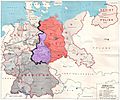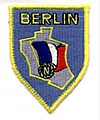British occupation zone facts for kids
The Allied powers won World War II against Nazi Germany. After the war, from 1945 to 1949, they split Germany into four occupation zones. This meant different parts of Germany were controlled by different countries.
The British zone included areas like Schleswig-Holstein, Hamburg, Lower Saxony, and what is now North Rhine-Westphalia. The British military government was based in a town called Bad Oeynhausen.
Even though Bremen and Bremerhaven were surrounded by the British zone, they were given to the United States so the Americans would have a port. What is now Rhineland-Palatinate was first meant for the British zone. But it was later given to the French to form part of their occupation zone.
In May 1949, the British, French, and American zones joined together. They formed a new country called the Federal Republic of Germany. The military leaders who were in charge were replaced by civilian high commissioners. These high commissioners acted like both governors and ambassadors. The occupation officially ended in 1955. This is when the Federal Republic became a fully independent country. The high commissioners were then replaced by regular ambassadors. However, the four Allied powers still had special rights in Germany until 1990. This was when the Final Settlement was signed.
The city of Berlin was special. It was not part of either the new West or East German states. Berlin stayed under Allied control until 1990.
Quick facts for kids
German Reich
Deutsches Reich
|
|||||||||||||||
|---|---|---|---|---|---|---|---|---|---|---|---|---|---|---|---|
| 1945–1949 | |||||||||||||||

Post-Nazi German occupation borders and territories from 1945 to 1949.
British (green), French (blue), American (orange) and Soviet (red) occupation zones. Saar Protectorate (light blue) in the west under the control of France. Berlin is the quadripartite area shown within the red Soviet zone. Bremen consists of the two orange American exclaves in the British sector. |
|||||||||||||||
| Status | Military occupation | ||||||||||||||
| Capital |
|
||||||||||||||
| Governors (1945) | |||||||||||||||
|
• British zone
|
F. Mar. Montgomery | ||||||||||||||
|
• French zone
|
Gen. Lattre de Tassigny | ||||||||||||||
|
• US zone
|
Gen. Eisenhower | ||||||||||||||
| Historical era | Cold War | ||||||||||||||
| 8 May 1945 | |||||||||||||||
|
• Allied Control Council
|
5 July 1945 | ||||||||||||||
| 15 December 1947 | |||||||||||||||
| 23 May 1949 | |||||||||||||||
| 7 October 1949 | |||||||||||||||
| 12 September 1990 | |||||||||||||||
| Population | |||||||||||||||
|
• 1945
|
64,260,000 | ||||||||||||||
|
• 1949
|
68,080,000 | ||||||||||||||
| Currency |
|
||||||||||||||
| ISO 3166 code | DE | ||||||||||||||
|
|||||||||||||||
| Today part of | |||||||||||||||
|
|||||||||||||||
 The four sectors of the Allied occupation of Berlin and exclaves. |
|||||||||||||||
Contents
Military Leaders and High Commissioners
After the war, military leaders were in charge of each occupation zone. They were called military governors. Later, these governors were replaced by high commissioners. These commissioners helped Germany become an independent country again.
British Zone Leaders
- From 1945 to 1946: Bernard Law Montgomery
- From 1946 to 1947: William Sholto Douglas
- From 1947 to 1949: Gen. Sir Brian Robertson
British High Commissioners
- From 1949 to 1950: Gen. Sir Brian Robertson
- From 1950 to 1953: Sir Ivone Kirkpatrick
- From 1953 to 1955: Sir Frederick Hoyer-Millar
Related Topics
Images for kids









